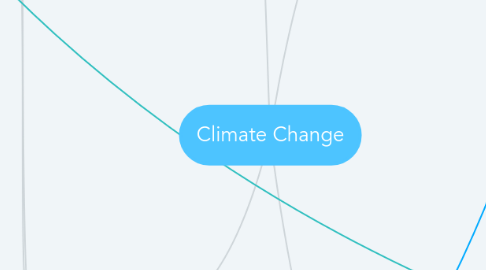
1. Causes
1.1. Accelerating Factors
1.1.1. GHG emissions
1.1.1.1. Carbon dioxide residence time
1.1.1.2. 40% increase over 150 yr
1.1.2. Changes in albedo
1.1.2.1. Loss of ice sheets & glaciers
1.1.2.2. Stefan-Boltzmann Law (positive feedback loop)
1.1.3. Solar output
1.1.3.1. 30% increase over 4.5 byr
1.1.3.2. Milankovitch cycle variations
1.2. Mitigating Factors
1.2.1. Decreased use of fossil fuels
1.2.1.1. Lowers carbon emissions
1.2.1.2. Aims to resolve national conflicts over petroleum
1.2.2. Increased use of renewable energy
1.2.2.1. Derived from power of natural resources
1.2.2.2. Not burn combustible organic matter
2. Solutions
2.1. Trade-offs
2.1.1. Mitigation
2.1.1.1. Public transport subidy
2.1.1.2. Importance of timing
2.1.1.2.1. Mitigation will not completely prevent climate change, still need some adaptation
2.1.1.2.2. Effects of climate change currently minimal
2.1.2. Adaptation
2.1.2.1. Zoning policy
2.1.2.2. Consequences
2.1.2.2.1. Beneficial
2.1.2.2.2. Unintended
2.2. Economic
2.2.1. Frameworks of Thinking
2.2.1.1. Pareto efficiency criterion
2.2.1.2. Kaldor-Hicks efficiency criterion
2.2.1.2.1. Do any action where the gains of the winners are larger than the losses of the losers
2.2.1.2.2. Compensation for losers by winners
2.2.1.3. Marginal thinking
2.2.1.4. Interest rates
2.2.1.4.1. Taken into account in decision-making for the future
2.2.1.4.2. How much something today pays out in the future
2.2.1.5. Discount rates
2.2.1.5.1. Short-term projects have higher rates of return
2.2.1.5.2. Current estimate of social cost of carbon is $37/ton based off of 3% discount rate
2.2.2. Strategies
2.2.2.1. Cap & trade
2.2.2.1.1. Sets aggregate limit on total pollution that is a predictable quantity
2.2.2.1.2. Emissions allowances are one-time purchases that can be traded
2.2.2.1.3. Price is set by the market & beneficial for the government to fund other initiatives
2.2.2.1.4. Shortcomings
2.2.2.1.5. Stakeholders
2.2.2.2. Carbon tax
2.2.2.3. Command & control
2.2.2.4. Pigouvian tax
2.2.2.5. Emissions-based subsidy
2.2.2.6. Border tax adjustment
2.3. Ethical
2.3.1. Frameworks of Thinking
2.3.1.1. Arming the future
2.3.1.1.1. Our responsibility today to consider implications of our actions on future people
2.3.1.1.2. Give future people choice to pick option not as bad as the other one they will face
2.3.1.2. Personal Responsibility
2.3.1.2.1. Inconsequentialism says our individual efforts contribute little to the solution and require a cost from a person's own life
2.3.1.2.2. Benefits of taking ownership of the issue
2.3.1.3. Virtue Ethics
2.3.1.4. Consequentialism
2.3.1.5. Deontology
2.3.2. Geoengineering Strategies
2.3.2.1. Spray sulfate aerosols
2.3.2.1.1. Power to make change in the people's hands
2.3.2.1.2. Fear of unintended consequences that cause more harm than good
2.3.2.1.3. Cost of designing apparatus and chemicals to carry out
2.3.2.1.4. More research needed to fully investigate benefits and potential side effects
2.3.2.1.5. Effects dependent upon residence time and relative impact to induce cooling
2.3.2.1.6. Stakeholders
2.3.2.2. Sequester CO2
2.3.2.3. Fertilize trees with NO2
2.3.2.4. Forest Restoration
3. Impacts
3.1. Ecological
3.1.1. Ocean
3.1.1.1. Rising sea levels
3.1.1.2. Loss of glaciers & ice sheets
3.1.1.3. Increase in ocean temperature
3.1.1.4. Increase in acidification
3.1.2. Regional climate
3.1.2.1. Increase in land temperature
3.1.2.2. Increase in extreme weather events
3.1.2.3. Increase in precipitation & pattern changes
3.2. Governmental
3.2.1. Consider investment options
3.2.1.1. Researching new technologies
3.2.1.2. Preserving natural resources
3.2.1.3. Studying changing patterns
3.2.1.4. No investment, would be a cost to own people
3.2.2. Consider Regulatory decisions
3.2.2.1. Limit fossil fuel availability
3.2.2.1.1. Decrease demand for fossil fuels
3.2.2.1.2. Lessen conflict overseas for petroleum
3.2.2.2. Limit amount of emissions
3.2.2.3. No regulation, would slow economic growth
3.3. Societal
3.3.1. Heightened awareness of energy consumption
3.3.1.1. Less high-consumption, luxurious acts during free time
3.3.1.2. Minimizing electric bills in homes, buildings, etc.
3.3.2. Emphasis on renewable energy use
3.3.2.1. Willingness to pay higher price for alternative energy
3.3.2.2. Switch from gas to battery powered
4. Uncertainties
4.1. If effects accelerate faster than expected...
4.1.1. Force people to immediate response of adaptation
4.1.2. Long-term response may be mitigation
4.1.3. Currently little motivation to pursue mitigation
4.1.3.1. Not going out of their way to take preventative measures because not experiencing harmful effects
4.1.3.2. Minor adaptations require less change
4.2. If full effects only harm vulnerable populations...
4.2.1. Urbanized countries responsible for harm incur cost to help vulnerable populations
4.2.2. Greater motivation for people of urbanized countries to change lifestyle
4.2.3. No actions taken for vulnerable populations because so distant and small
4.3. If a solution leads to undesired side effects...
4.3.1. Questions of how to hold countries accountable
4.3.1.1. Punish those who implemented solution
4.3.1.2. Force them to compensate affected people
4.3.1.3. Do nothing because intent was pure and unintended side effects occurred
4.3.2. Questions of how to distinguish who the affected people are
4.4. If change in political powers shift outlook on climate change to minimize its importance...
4.4.1. Questions of who the responsibility now falls on
4.4.2. Questions of whether foreign countries are responsible for intervening
